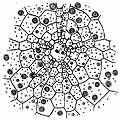The Echinoid Directory
Paleotrema Koehler, 1914, p. 45
[=Palaeotrema Mortensen, 1950, p. 299 (incorrect emendment)]
| Diagnostic Features |
|
|---|---|
| Distribution | Recent, Indo-West Pacific, 175-685 m. |
| Name gender | neuter |
| Type | Palaeotropus loveni A. Agassiz, 1881, p. 204, by original designation. |
| Species Included |
|
| Classification and/or Status |
|
| Remarks |
|





